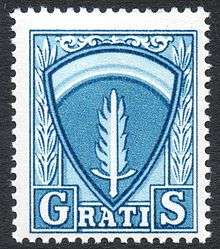Allied Military Government for Occupied Territories
Allied Military Government for Occupied Territories | |
|---|---|
| Official languages | |
| Type | Military occupation |
| Currency | |



The Allied Military Government for Occupied Territories (originally abbreviated AMGOT, later AMG) was the form of military rule administered by Allied forces during and after World War II within European territories they occupied.
Notable AMGOT
This form of controlled government was implemented in the states of Germany, Italy,[2] Austria and Japan, amongst others.
Opposition of France

US President Franklin Roosevelt insisted that an AMGOT should be implemented in France, but this was opposed by both Henry Stimson, the US Secretary of War, the US Under-Secretary for War, as well as Allied Europe Supreme Commander, General Dwight Eisenhower, who had been strongly opposed to the imposition of AMGOT in North Africa. Eisenhower, unlike Roosevelt, wanted to cooperate with Charles de Gaulle, and he secured a last-minute promise from Roosevelt on the eve of D-Day that the Allied officers would not act as military governors and would instead cooperate with the local authorities as the Allied forces liberated French territory. De Gaulle would, however, later claim in his memoirs that he blocked AMGOT.[3]
The AMGOT would have been implemented in France after its liberation if not for the Free French establishing control of the country per the Provisional Government of the French Republic in the name of the Free French Forces and the united French Resistance (FFI) following the liberation of Paris by the French themselves instead of the Allies, in August 1944.[4]
Germany
Germany's control was notably divided amongst the powers of the Soviet Union, the United States, the United Kingdom, and France.
Italy
Sicily
After the Operation Husky, with the Allied Invasion of Sicily, July 10, 1943 was established the Allied Military Government with chief Lord Francis Rodd, 2nd Baron Rennell and at civil affairs the colonel Charles Poletti, until February 1944.
Free Territory of Trieste
The Allied Military Government of Zone A of the Free Territory of Trieste was a follow-on from the military government of occupied Italy. It was established upon implementation of the Treaty of Peace with Italy, 15 September 1947, which created the free territory divided into two zones. Zone A was administered by the United States and the United Kingdom. Zone B was administered by Yugoslavia. Military government ended when the free territory was divided between Italy and Yugoslavia, November 1954, under the provisions of the London Memorandum, a memorandum of understanding among the United States, United Kingdom, Italy and Yugoslavia.
See also
- Allied Commission
- A Bell for Adano is a 1944 novel by John Hersey centered on the AMGOT control of the fictional Italian village of Adano based in the village of Licata.
References
- ↑ "Germany: Allied Military Government Travel Permits 1947-51" by Theo J.F. Schalke in The Revenue Journal, Vol. XXII, No. 3, December 2011, pp. 129-139.
- ↑ Friendly Isle, Time, July 26, 1943
- ↑ Kim Munholland, Rock of Contention, Free French and Americans at War in New Caledonia 1940–1945, Berghahn Books, New York, Oxford, 2005, p. 190.
- ↑ Charles L. Robertson, "When Roosevelt Planned to Govern France"
Trieste Revenue stamps listed in Italy Revenues" by J.Barefoot Ltd, York, 2013, ISBN 0-906845-73-4.